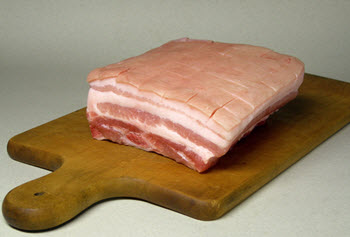 A pork belly is a boneless cut of fatty meat from the belly of a pig. Pork bellies can be salted and/or smoked to preserve them without the need for refrigeration (but nowadays freezing them is common). In the United States, trade in pork bellies really took off in the 19th century when as a lot of people moved into cities (thus not raising their own pigs anymore) and the expanding railroad system made it possible to transport pork bellies for a comparatively low cost.
A pork belly is a boneless cut of fatty meat from the belly of a pig. Pork bellies can be salted and/or smoked to preserve them without the need for refrigeration (but nowadays freezing them is common). In the United States, trade in pork bellies really took off in the 19th century when as a lot of people moved into cities (thus not raising their own pigs anymore) and the expanding railroad system made it possible to transport pork bellies for a comparatively low cost.
On August 18, 1961, the first pork belly commodities futures contract was created by the Chicago Mercantile Exchange (MCE). Meat packers who processed and sold pork wanted a way to decrease their exposure to the volatility of the pork belly price and the volatility of the price of processed pork products, such as bacon. By using pork belly futures contract, they could manage risk and plan their business better. The unit of trading for these futures contracts was 20 short tons of frozen, trimmed pork bellies.
Trading in pork belly futures contracts
Futures contracts for pork belly are no longer traded on the Chicago Mercantile Exchange (CME) in the United States, but they are still traded on the Dalian Commodities Exchange (DCE) in China. They were delisted for trading at CME on July 18, 2011.
The spot price for pork belly tend to vary depending on seasonal demand for pork products, the amount of inventory held in storage and the cost of grain. (Grain is used to feed the pigs.)
This article was last updated on: January 18, 2016